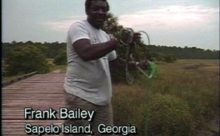The Gullah
The following information about Gullah culture and history—comes from a teachers’ guide published by South Carolina Educational Television to accompany its documentary Family Across the Sea (2003). For more essays from that booklet about the history of slavery and the Gullah language, storytelling, other arts, history, and present-day challenges for the Sea Island people see the homepage for Family Across the Sea on Folkstreams.
A slender, subtropical line hugs the American coastline from the Carolinas to north Florida—an uncommonly fertile complex of thickly wooded sea islands and black-loamed mainland, punctuated by broad savannahs and salt marsh. Interlacing inlets, rivers and winding tidal creeks separate island from island, deep swamp from pine forest. A chain of thin, sandy barrier islands fronts the Atlantic Ocean, a protection against hurricane and sea.
Today, this "lowcountry" remains largely undeveloped. A century ago, however, this was no forgotten Eden. Huge plantations stretched the length of the coastline—thriving, bustling entities comprising thousands of acres. Crops of indigo, rice and cotton brought an immense wealth to the area—worked by scores of people brought from another, remarkably similar land to this one—lands far across the ocean in West Africa.
These African slaves brought with them their own wealth—a cultural heritage as rich in language, lore, custom and continuity as any ever recorded.
The Civil War and After
At the close of the American Civil War, many of the once immense Low-country plantations fell into ruin. Rice farming, which had once been so lucrative, was not economically feasible without a large, inexpensive labor force. Although attempts were made to continue to cultivate rice after the war, back-to-back hurricanes at the close of the 19th century destroyed the few remaining fields. The last rice crops in South Carolina were harvested from Hampton Plantation, near McClellanville, marking the end of an era lasting two centuries. The luxuriant Sea Island cotton, once so highly prized, fell to the ravages of the boll weevil. The agricultural economy changed to small truck farms; the landowners assimilated into modem, town-based societies. And the land slowly reverted to its wild, untamed state.
Those who remained were the ex-slaves, and later, their descendants. For years, they fished, farmed and lived a life largely untouched by modem life. Only with the development of barrier islands as tourist resorts have these people become part of 20th-century life.
As a group, they are called the Gullah, and on the Georgia coast, the Geechee. There was a time in the not- so-distant past that their ways—their seemingly unintelligible language, their nature-born medicines, archaic customs and folkways—were regarded as "quaint" by white people and a matter of personal embarrassment for the up-and-coming black man or woman.
In truth, the Gullah hold one of the most direct links to their African beginnings. The old ways survived, and, in some ways, thrived in the isolation of the Lowcountry Sea Islands, ways now appreciated and studied. For the Gullah hold the genesis of the African-American culture; they represent a sophisticated determination of a transplanted people to preserve their origins.
Much has been written about the Gullah over the past century. We have met them in story and song— through the tales of Uncle Remus, the opera Porgy and Bess, and Julia Peterkin's Pulitzer Prize-winning novel, Scarlet Sister Mary. Their speech has long been a fascination to folklorists, and later, anthropologists and linguists. Over the years, a considerable body of literature has arisen on the Gullah language, and today's student has a broad base from which to study.
The exact historical origins of this language are still in question. One must reach back through centuries of change to reconstruct its beginnings. While the grammar is African, the vocabulary is English, French, Spanish, Portuguese, German, Scottish and Irish words and phrases intermingled with various African tongues. Their speech became a reflection of the Africans' entire immigration experience.
Today, both Gullah language and customs are endangered by a rapidly changing environment. Bridges and automobiles now make access to towns and cities easy, where before, the trip was a daylong trek by mule and boat. Conversely, tourists and townspeople invade the once inaccessible Sea Islands, flocking to the resorts, playing golf on courses that were once plantation cotton fields. White-washed cabins trimmed in light blue paint to ward off evil spirits have given way to mobile homes and televisions. Many small farms lay fallow as people have gone to work at the resorts or in the city. A way of life is going through abrupt changes.
The importance of the Gullah people and their language cannot be overestimated. During slavery, the language linked people of varied backgrounds and tongues, providing a vital mode of expression and communication. Today, it links a people to their past, a living heritage with roots that go deep into African soil.
